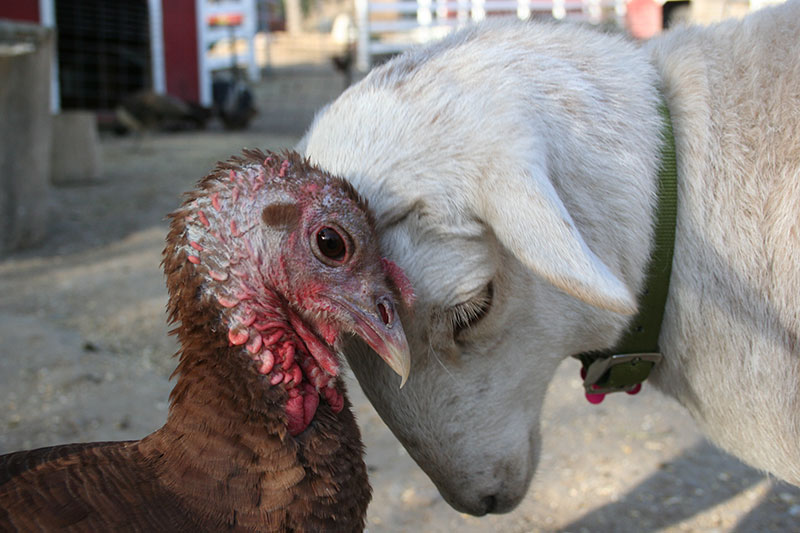Many Thanksgiving and Christmas dinners revolve around eating turkey. Below is some information you may not know about these complex creatures. Now that we enjoy plant-based meals at my house, the holidays are an opportunity to express gratitude for all animals. In fact, we often place photos of some turkey friends from Animal Acres Farm Sanctuary (www.animalacres.org) on the Thanksgiving table. And because there are so many vegan holiday recipes to wow you and your family (more coming soon), it's easy to keep your holiday meals cruelty-free!
Turkeys
| ||
| By Karen Davis, PhD, author and founder of United Poulty Concerns This article appears in the November 2006 issue of Satya magazine. "My first encounter with turkeys took place at Farm Sanctuary where I worked as a volunteer one summer. There was a flock of about twenty white turkey hens and two bronze turkeys named Milton and Doris. One thing that impressed me then, and has stayed in my mind ever since, was how the turkeys’ voices, their yelps, floated about the place in an infinitely plaintive refrain. Another was how one or more of the female turkeys would suddenly sit down beside me in the midst of my work, with her wings stiff and her head held high, awaiting my attention.
Biologist William M. Healy has described the importance of bonding between young turkeys and their mothers for normal social development. He notes that much of what biologists know about wild turkey intelligence is based on work with domestic turkeys. He defends turkeys from the charge of stupidity by observing that genetic manipulation of turkeys for “such gross breast development that few adult males can even walk, let alone breed” creates demeaning stereotypes. Poultry specialist Dr. Ian Duncan of the University of Guelph, Ontario, states unequivocally that “turkeys possess marked intelligence [as] revealed by such behavioral indices as their complex social relationships, and their many different methods of communicating with each other, both visual and vocal.” Likewise, Oregon State University poultry science professor, Dr. Tom Savage, says of the turkey disrespect displayed in the popular media: “They have no idea what they are talking about.” I know from experience that turkeys who have lived their entire lives in industry settings can roam the woods and find their way back to the yard as soon as they get to our sanctuary. Despite the terrible things that have been done to their bodies – the gruesome genetics and mutilation of their toes and beaks at the hatchery – factory farm turkeys are alert to their surroundings and one another. While researching my book More Than a Meal: The Turkey in History, Myth, Ritual, and Reality, I learned other things about turkeys. For instance, they “transplant” sound from one bird to another within the flock at a moment’s danger. They also dance. In Illumination in the Flatwoods: A Season with the Wild Turkey, naturalist Joe Hutto describes how one morning in August, his three-month-old turkeys, upon seeing him, dropped from their roosting limbs where they had sat “softly chattering” in the dawn, “stretched their wings and did their strange little dance, a joyful, happy dance, expressing an exuberance.” And a witness who chanced upon an evening dance of adult birds wrote: I heard a flock of wild turkeys calling. They were not calling strayed members of the flock. They were just having a twilight frolic before going to roost. They kept dashing at one another in mock anger, stridently calling all the while, almost playing leapfrog in their antics. Their notes were bold and clear. For about five minutes they played on the brown pine-straw floor of the forest, then as if at a signal, they assumed a sudden stealth and stole off in the glimmering shadows.
Turkeys have a mysterious empathy with one another under duress, and they can be fierce fighters as well. A turkey mother will fight vigorously to protect her young, as described by an observer of the following drama in rural Virginia: I saw a turkey coming into the back field. She had about 10 babies the size of large quail walking with her. Without warning, the hen took off vertically as if she had stepped on a mine. About 20 feet off the ground, she intercepted and attacked a hawk that was coming in for a baby. The hen hit the hawk with her feet first and with her back almost parallel to the ground. The hawk flew toward the back of the field with the hen in pursuit; it turned back towards the babies, and the hen hit it again. They both fell about 10 feet and were fighting with their feet, until the hawk headed for the tree line and kept going. The hen returned to her babies. When they went back into the pines, the babies were very close to their mother’s feet. Let us remember that turkeys need our help and they deserve our respect.  Between April and July 2006, PETA investigators documented horrific cruelty to turkeys at the Butterball slaughter plant in Ozark, Arkansas. Butterball turkeys are hung upside down, shocked in painful electrified water that paralyzes and does Not stun them. Their necks are then partially slit and, dead or alive, they are thrown into scalding water. Adding to their misery, workers were taped stomping on live turkeys, slamming them against walls, exploding their skulls and popping out their spines with sadistic glee. This is the culture of slaughter. Please don’t support it. Order our vegan cookbook Instead of Chicken, Instead of Turkey: A Poultryless “Poultry” Potpourri for delicious, easy recipes, and More Than a Meal: The Turkey in History, Myth, Ritual, and Reality for the cultural, literary, and natural history of turkeys.* * Note: You'll also find plenty of cruelty-free holiday recipes this month and next in The Daily Vegan. | ||



No comments:
Post a Comment